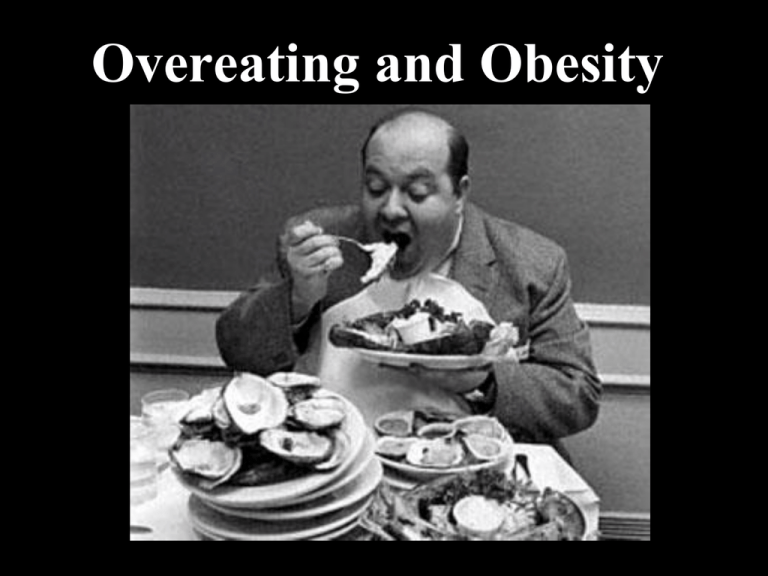Overeating & Obesity
advertisement

Overeating and Obesity “Mmmm diabetes here I come!” What is considered overweight? The body mass index (BMI) is an internationally recognised standard for classifying overweight and obesity in adults. BMI is calculated by dividing the weight in kilograms by the square of the height in metres. For people aged 18 years and over, a BMI of 25 or more is considered overweight, and 30 or more is obese. What causes overweight? While many factors may influence an individual's weight, overweight and obesity is due mainly to an imbalance of energy intake from the diet and energy expenditure through physical activity. Genetic and environmental factors play a role, but attention to diet and physical activity is important not only for preventing weight gain, but also for weight loss and subsequent maintenance. What are our options to fight our population overeating and put an end to Obesity?... Let the Fight Begin…. We can be proactive and implement as many prevention initiatives and programs as possible. VS We can continue to be reactive and wait for Australians to develop chronic lifestyle diseases and treat them with surgery or medication. Putting a greater strain on the health care system, increasing the cost to the Australian society. Overeating and Obesity PREVENTION STRATEGIES Healthy Eating Is an important prevention strategy in regards to obesity. A balanced diet requires a balanced intake of 'macronutrients' (fats, carbohydrates, proteins) and 'nutrients' (vitamins and minerals). Healthy Eating Study Holm (2002) • • • • Health campaigns have been criticised for being ineffective yet Holm (2002) conducted a survey that investigated the efficiency of health companies in Denmark. He claims that campaigns are effective but they cannot stand by themselves. They can establish a norm for what is considered healthy behaviour. A successful health campaign in Denmark aimed to decrease the use of butter on rye bread sandwiches that are a common lunch in the country. From 1985 to 2001 the number of people who said they did not use butter on their sandwiches increased from 7 to 40%. The use of low fat milk has also changed after health campaigns, showing that they can be successful. Holm claims that there was a long term effect of all the health campaigns in Denmark as they contributed to the people's knowledge and motivation to change unhealthy habits. According to Holm, successful campaigns must address 3 levels: what the individual can do, what can be done by the community and what the government can do. Healthy Eating Prymid Models for healthy eating, such as the 'Healthy eating pyramid' and the 'Eatwell plate' proposed by the British Nutrition Foundation (2007) advocate healthy eating by suggesting the recommended proportions, quantities and types of food that people should eat. Physical Activity What is there for physical activity? “Go from flab …. Changing the physical environment (more stairs and fewer escalators) can help individuals undergo more physical activity. Also, creating more exercise facilities, gyms and areas for exercise can encourage physical activity. Private or public health services that can help people change their behaviour (for example, doctors, pharmacies). …..to FAB!” Also, the government is funding personal trainer courses, so that there will be more people in that occupation. Their thinking is that if more people go to personal training, the strain on the healthcare system will be relieved. Government Lifestyle Campaigns for Obesity Prevention • SWAPIT CAMPAIGN :The Australian government has implemented many strategies to help people win the battle with obesity. One of the most recent of the government’s strategies is the SwapIt campaign, in which people are advised not to miss out the activity, just do something similar that is a healthier option. It encourages Australians to change their mindset (cognitive) when dealing with weightloss, so that they are not seen to be ‘dieting’. This may allow the negative stigma associated with dieting to be alleviated: that you have to miss out on the things that you enjoy if you want to be healthy. Australia’s 'Go For Your Life’ Campaign The Australian prevention campaign 'Go For Your Life' encourages children to enjoy healthy eating and physical exercise. The program includes messages such as… • Drinking water everyday • Decreasing screen time and increasing active play • Putting more fruit and vegetables in your lunchbox • Increasing physical activity • Limiting sugary foods • Increase active modes of transport Overeating and Obesity TREATMENTS Treatment Research Foster (2006) Treatments based on Classical Conditioning is successful as they help patients identify cues triggering inappropriate eating and then learn new responses to them Jackson (2008) Reinforcing children for eating creates compulsions leading to obesity, Operant Conditioning in childhood is to blame Hardeman et al. (2000) Treating obesity by role models encouraging healthy lifestyles led to significant weight loss Wing et al. (2002) Treatments based on Classical Conditioning incur average weight loss of 15.6kg in 18 months, i.e. it works Devlin (1995) Treatments based on Operant Conditioning resulted in weight loss not being maintained Weight loss after Social Learning Theory treatments tend to be short term, suggesting that other explanations should be considered. Dieting “A special course of food to which one restricts oneself, either to lose weight or for medical reasons” Dieting Studies • Wadden (1993) reviewed several studies to establish the effect of moderate and severe calorie restriction on weight loss. It was found that if an individual stayed in a treatment programme for 20 weeks or more, 50% lost 9kg or more. However it was also found that in the long term participants tended to regain the lost weight, leading to the conclusion that weight gain after the treatment is the norm. • Brownell et al. (1989) researched weight loss in rats and found that repeated weight loss was followed by weight regain. Weight loss therefore becomes difficult due to decreased metabolism and an increase in the percentage of body fat. The researchers found similar results in human dieters and athletes who yo-yo dieted. • Heatherton et al. (1991) claims dieting can predict weight fluctuations in the non-obese. CBT - Cognitive behavioural Therapy To deal with problematic aspects of the condition: • • • • Eating Behaviour Involvement in physical activity Body image dissatisfaction Participation in social life CBT Study Stahre et al. (2007) They conducted a randomized trial with Swedish women who were overweight. Half were exposed to CBT treatment and the other were exposed to exercise treatment. At the end of the 10 week trial the participants weight was controlled after an 18-month period and only little fall outs came from both groups. Weight loss was 5.9kg after the 18-month follow up with sufferers exposed to CBT treatment. The control group gained on average 0.3kg after the 18-month follow up. CBT Study Kylie Ball (Deakin University) Kylie Ball monitored trends of obesity in Australia. Despite increased awareness and focus on the importance of fitness and healthy living Australians continue to gain weight. In order to effectively address obesity and to maintain good health the underlying problems of the condition must be addressed. CBT allows this as it also improves selfesteem and quality of life. The problem with CBT is that it demands a lot of work from the client which may not always be accepted or followed through. Drug Treatments Drug treatments are recommended in combination with healthy eating and regular physical exercise. Few studies have evaluated the safety and long term effectiveness of such drugs and some are concerned they are over prescribed. Appetite suppressant drugs decrease appetite or increase the feeling of being full by increasing the number of neurotransmitters that affect mood and appetite (serotonin and adrenaline). They are generally considered effective yet they can side effects such as nausea, constipation and a dry mouth. Lipase inhibitors act on the gastro intestinal system to reduce fat absorption. They can have unpleasant side effects, particularly after a meal with a high fat content. This in itself could have a preventative effect as eating fat becomes associated with unpleasant consequences. Drug Treatments Study Berkowitz et al. (2006) • It was a longitude study • Trial with a sample of adolescent boys and girls • Investigated if a appetite-suppressant drug reduced weight more than a placebo in obese adolescents • Participants also received counselling about how to eat less food, increase physical activity, reduce stress and keep track of how much they ate • Average rate of participants at the beginning of the study was 97.7kg • Those who took the drug averaged weight loss of 6.4kg • Those who took the placebo averaged weight gain of 1.8kg Surgical Treatment Gastric bypass involves cutting off part of the stomach, such as through stapling so that it can no longer absorb food. Gastric banding involves putting a band around the upper part of the stomach so that only a small part can receive food, causing the patient to feel full sooner. Surgical Treatment Study Maggard et al. (2005) They conducted a meta-analysis of 147 studies. Surgery resulted in weight loss of 20-30kg which was maintained for up to 10 years and also resulted in a general improvement in health. Gastric bypass was concluded to be more efficient than gastric banding. Himpens, Cadiere & Bazi et al (2011) The University Obesity Centre in Brussels, Belgium 82 patients, 12 years after the surgery. Half of the people no longer had their gastric bands Some had them removed, some didn’t want it, and some didn’t work well enough • 4 in 10 had serious complications • 6 in 10 needed follow up operations • Concluded that gastric band surgery had a mean weight loss of 42.8% after 12 years. However, since nearly 50% of patients required the removal of the band, it can be concluded that gastric band surgery has poor long-term outcomes. • • • •







